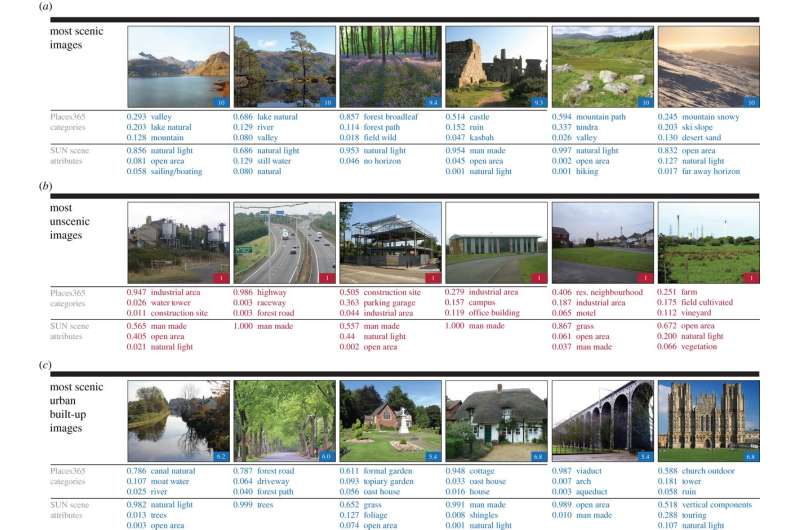July 19, 2017 report
Using deep learning to get computers to recognize beautiful places

(TechXplore)—A trio of researchers with the University of Warwick in the U.K. has used a deep learning algorithm to help a computer system better understand what constitutes a beautiful place. In their paper published in the journal Royal Society Open Science, the group describes how they trained their system, how well it worked and possible applications.
Beauty, as the saying goes, is in the eye of the beholder. That being said, humans are remarkably consistent when appraising the beauty of a person, place or thing. Show slides of places around the globe to a group of individuals, and they will most likely agree on which are beautiful places and which are eyesores. In this new effort, the researchers sought to use a deep learning algorithm to give a computer the same sort of ability.
To teach the computer system, the researchers fed it 20,000 pictures posted on the website Scenic-or-Not, which, as its name implies, allows visitors to rate photos of British locations on how beautiful or ugly they are. The researchers also fed the ratings into the computer. The deep learning system analyzed the images, noting similarities and differences between them looking for features identified with beauty. It then used what it had learned to create a ratings system for itself that could be used as a means to judge whether a given image was beautiful or ugly.
In testing the system, the researchers found it to be quite accurate—it found pictures of South Wheal Frances, Embley Wood and Loch Scavaig to be quite beautiful, for example, as would most people. And it found places like the A42, the old Brancepeth Works and a view of Rake Lane in Cheshire to be quite ugly, as many have noted on social media.
Notably, the researchers found that the system identified beauty in both the natural and man-made world, just as humans do, though notably, it also panned some scenes that people might argue are quite beautiful—like stretches of flat green grass.
More information: Chanuki Illushka Seresinhe et al. Using deep learning to quantify the beauty of outdoor places, Royal Society Open Science (2017). DOI: 10.1098/rsos.170170
Abstract
Beautiful outdoor locations are protected by governments and have recently been shown to be associated with better health. But what makes an outdoor space beautiful? Does a beautiful outdoor location differ from an outdoor location that is simply natural? Here, we explore whether ratings of over 200 000 images of Great Britain from the online game Scenic-Or-Not, combined with hundreds of image features extracted using the Places Convolutional Neural Network, might help us understand what beautiful outdoor spaces are composed of. We discover that, as well as natural features such as 'Coast', 'Mountain' and 'Canal Natural', man-made structures such as 'Tower', 'Castle' and 'Viaduct' lead to places being considered more scenic. Importantly, while scenes containing 'Trees' tend to rate highly, places containing more bland natural green features such as 'Grass' and 'Athletic Fields' are considered less scenic. We also find that a neural network can be trained to automatically identify scenic places, and that this network highlights both natural and built locations. Our findings demonstrate how online data combined with neural networks can provide a deeper understanding of what environments we might find beautiful and offer quantitative insights for policymakers charged with design and protection of our built and natural environments.
© 2017 TechXplore




















